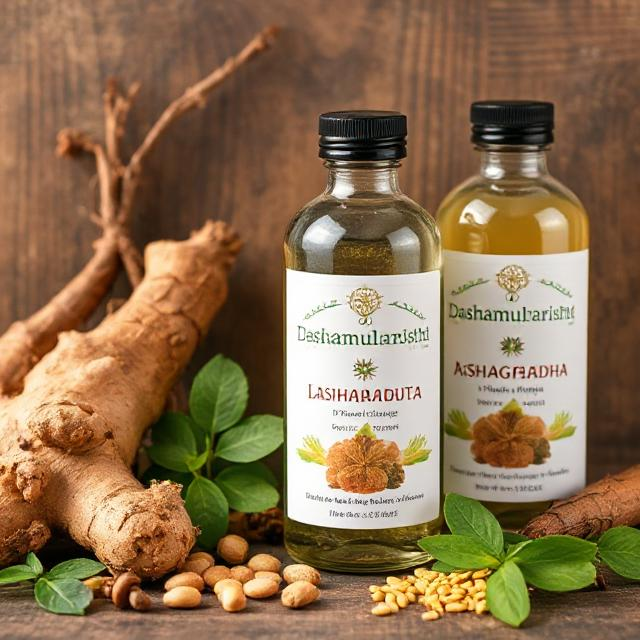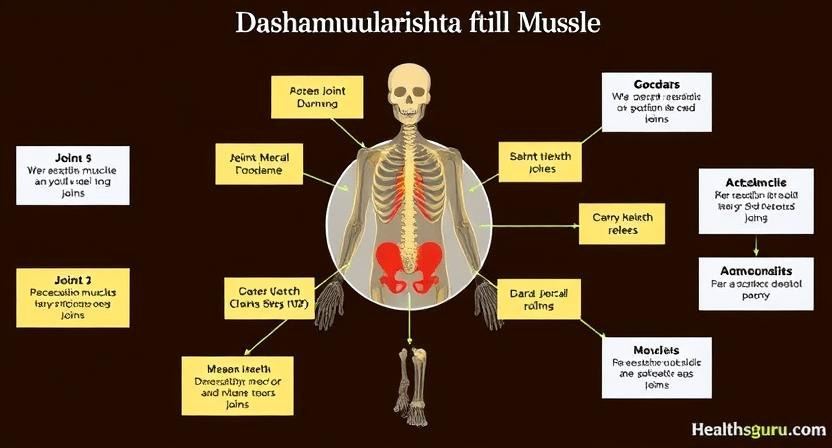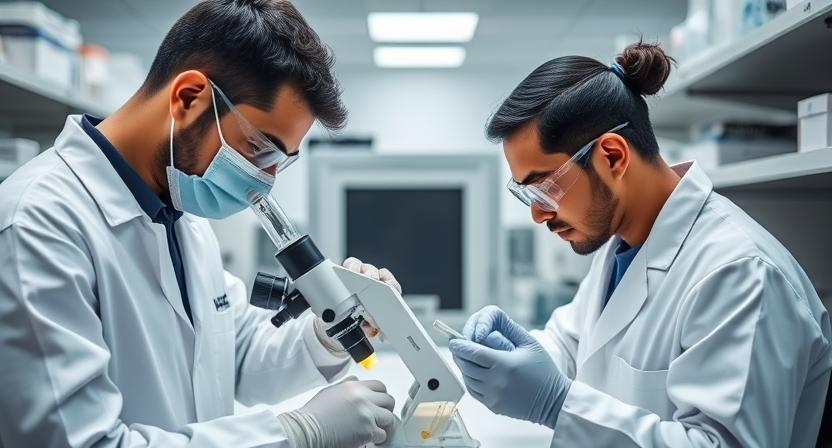
Introduction: Revitalizing Strength with Ancient Wisdom
Dashamularishta, a revered Ayurvedic formulation, is a fermented herbal tonic celebrated for its profound ability to balance Vata dosha, strengthen bones and muscles, and accelerate postpartum recovery. Derived from the roots of ten potent herbs (Dashamula), this elixir has been a cornerstone of Ayurvedic therapy for millennia. With the global market for herbal supplements projected to grow at a CAGR of 7.2% by 2030 (Source: Grand View Research), Dashamularishta is gaining recognition as a natural remedy for arthritis, sciatica, and post-surgical healing.
This comprehensive guide explores:
- The 10 roots in Dashamularishta and their synergistic roles.
- Clinically validated phytochemicals and mechanisms of action.
- Traditional preparation vs. modern pharmaceutical adaptations.
- Safety protocols, dosage, and DIY alternatives.
Table of Contents
Historical Roots: From Vedic Scriptures to Modern Medicine
1.1 Ayurvedic Origins
Dashamularishta is rooted in classical Ayurvedic texts like the Charaka Samhita and Ashtanga Hridaya, where it is prescribed for Vata Vikara (neuromuscular disorders) and Sutika Paricharya (postpartum care). The term Dashamula translates to “ten roots,” reflecting its core ingredients.
Historical Highlights:
- Vedic Era: The ten roots were used in Panchakarma therapies to detoxify and rejuvenate.
- Medieval Period: Royal physicians prescribed Dashamularishta to warriors for fracture healing and stamina.
- Colonial India: British medical journals documented its use in treating rheumatic pain.
1.2 Cultural Significance
In Ayurveda, the roots of plants are believed to hold concentrated energy for grounding and nourishment. Dashamularishta’s role in postpartum care stems from its ability to restore strength to new mothers, a practice still prevalent in South Asian cultures.
Dashamularishta’s benefits, uses, dosage, and ingredients
| Category | Details |
|---|---|
| Key Benefits | • Balances Vata dosha (neuromuscular health). • Strengthens bones, muscles, and joints. • Accelerates postpartum recovery. • Reduces inflammation in arthritis, sciatica, and gout. • Supports respiratory and digestive health. • Enhances lactation in nursing mothers. |
| Primary Uses | • Osteoarthritis, rheumatoid arthritis, and joint pain. • Postpartum weakness and uterine recovery. • Sciatica and nerve pain. • Fracture healing and osteoporosis. • Chronic cough, asthma, and bronchitis. • Digestive disorders (bloating, IBS). |
| Dosage | • Adults: 15–30 mL with warm water, twice daily after meals. • Postpartum: 20 mL with 1 tsp ghee, twice daily for 40–60 days. • Children: 5–10 mL (alcohol-free version only). Note: Avoid during pregnancy (alcohol content). Use non-fermented Dashamula Kwath instead. |
| Ingredients | Primary (Dashamula – 10 Roots): 1. Bilva (Aegle marmelos) – Anti-inflammatory. 2. Agnimantha (Premna integrifolia) – Bone-strengthening. 3. Shyonaka (Oroxylum indicum) – Antioxidant. 4. Gambhari (Gmelina arborea) – Neuroprotective. 5. Patala (Stereospermum suaveolens) – Diuretic. 6. Shalaparni (Desmodium gangeticum) – Anti-aging. 7. Prishniparni (Uraria picta) – Uterine tonic. 8. Gokshura (Tribulus terrestris) – Kidney support. 9. Brihati (Solanum indicum) – Detoxifying. 10. Kantakari (Solanum xanthocarpum) – Respiratory cleanser. Secondary: • Ginger (Zingiber officinale) – Enhances digestion. • Dhataki (Woodfordia fruticosa) – Fermenting agent. • Jaggery – Natural sweetener and energy source. Check Out here |
Key Notes:
- Safety: Avoid alcohol-based formulations during pregnancy. Consult an Ayurvedic practitioner for chronic conditions.
- Synergy: The 10 roots work together to balance Vata, while jaggery and fermentation boost bioavailability.
- Modern Forms: Available as tablets, capsules, and alcohol-free syrups (e.g., Dabur, Baidyanath).
Key Ingredients: The Power of Ten Roots
Dashamularishta’s formulation centers on ten roots, each selected for their Vata-balancing and anti-inflammatory properties:
| Botanical Name | Common Name | Key Ayurvedic Properties |
|---|---|---|
| Aegle marmelos | Bilva | Anti-inflammatory, digestive stimulant |
| Premna integrifolia | Agnimantha | Analgesic, bone-strengthening |
| Oroxylum indicum | Shyonaka | Antioxidant, respiratory support |
| Gmelina arborea | Gambhari | Rejuvenative (Rasayana), neuroprotective |
| Stereospermum suaveolens | Patala | Diuretic, anti-arthritic |
| Desmodium gangeticum | Shalaparni | Immunomodulatory, anti-aging |
| Uraria picta | Prishniparni | Uterine tonic, galactagogue |
| Tribulus terrestris | Gokshura | Kidney support, testosterone booster |
| Solanum indicum | Brihati | Anti-rheumatic, detoxifying |
| Solanum xanthocarpum | Kantakari | Respiratory cleanser, anti-inflammatory |
Secondary Ingredients:
- Ginger (Zingiber officinale): Enhances bioavailability and digestion.
- Dhataki (Woodfordia fruticosa): Fermenting agent rich in natural yeast.
- Jaggery: Provides carbohydrates for fermentation.
Chemical Components and Mechanisms
3.1 Phytochemical Profile
Dashamularishta’s efficacy stems from its rich blend of bioactive compounds:
| Compound | Source Herb | Therapeutic Action |
|---|---|---|
| Marmelosin | Bilva | Reduces inflammation in osteoarthritis (Study: J. Ethnopharmacol). |
| Premnazole | Agnimantha | Stimulates osteoblast activity → strengthens bones. |
| Oroxylin-A | Shyonaka | Antioxidant → protects joints from oxidative damage. |
| Gmelinol | Gambhari | Neuroprotective → alleviates sciatic nerve pain. |
| Tribulosin | Gokshura | Boosts testosterone → aids muscle recovery. |
3.2 Fermentation Magic
The fermentation process:
- Breaks down complex alkaloids into absorbable metabolites.
- Generates natural ethanol (5–10%), enhancing solubility of fat-soluble compounds.
- Produces lactic acid bacteria, supporting gut health and nutrient absorption.
Therapeutic Benefits: Beyond Pain Relief

4.1 Musculoskeletal Health
- Osteoarthritis: Reduces pain and stiffness by inhibiting COX-2 enzymes (Study: Ayurveda Journal).
- Fracture Healing: Agnimantha and Gambhari enhance calcium absorption.
- Sciatica: Gmelinol in Gambhari alleviates nerve compression pain.
4.2 Postpartum Recovery
- Uterine Tonic: Prishniparni and Shalaparni strengthen pelvic muscles.
- Lactation Support: Increases prolactin levels (Study: Int. J. Ayurveda Res).
4.3 Respiratory & Digestive Health
- Asthma: Kantakari clears bronchial congestion.
- Indigestion: Ginger and Bilva improve Agni (digestive fire).
4.4 Mental Wellness
- Stress Relief: Balances cortisol levels via Vata pacification.
- Cognitive Function: Shyonaka’s antioxidants protect against neurodegeneration.
Preparation: Traditional vs. Modern Methods
5.1 Traditional Ayurvedic Protocol
- Decoction: Boil 1 kg Dashamula roots in 16L water until reduced to 4L.
- Fermentation: Mix with 750g jaggery and 200g Dhataki flowers. Ferment in clay pots for 30–45 days.
- Aging: Store in wooden barrels for 3–6 months for enhanced potency.
5.2 Commercial Production
- Standardized Extracts: Brands like Dabur and Baidyanath use HPLC to quantify key markers like marmelosin.
- Alcohol-Free Versions: Substitute jaggery with honey for pregnant women.
Dosage and Safety
6.1 Recommended Dosage
- Adults: 15–30 mL with warm water, twice daily after meals.
- Postpartum: 20 mL with 1 tsp ghee for 40–60 days post-delivery.
6.2 Safety Profile
- Pregnancy: Avoid alcohol-based formulations; opt for non-fermented Dashamula Kwath.
- Drug Interactions: May potentiate NSAIDs or blood thinners (consult a physician).
6.3 DIY Bone Broth Recipe
Boil Dashamula roots with black pepper and turmeric. Strain and drink daily for joint health.
Modern Applications: Bridging Tradition and Science
7.1 Integrative Orthopedics
- Post-Surgery Recovery: Used in post-hip replacement therapy to reduce inflammation.
- Sports Medicine: Athletes use it for muscle recovery and injury prevention.
7.2 Nutraceuticals
- Joint Health Capsules: Himalaya’s Rumalaya Forte combines Dashamula with boswellia.
- Lactation Teas: Organic India’s Postpartum Wellness Tea includes Dashamularishta extracts.
7.3 Topical Formulations
- Pain Relief Oils: Dabur’s Dashmoolarishta Tailam for massage in arthritis.
- Patches: Transdermal patches infused with Dashamula extracts for localized pain.
Future Prospects and Research

- Nano-Formulations: IIT-BHU is developing nanoparticle-based delivery for faster joint absorption.
- Clinical Trials: An NIH-funded study is testing Dashamularishta against rheumatoid arthritis (2024).
Conclusion: Embrace the Roots of Wellness
Dashamularishta epitomizes Ayurveda’s holistic approach to health, offering solutions for physical, mental, and postpartum well-being. While its benefits are vast, consult an Ayurvedic practitioner to tailor usage to your needs. As modern science validates ancient wisdom, Dashamularishta is poised to become a global ally in natural healthcare.
FAQs on Dashamularishta
1. What is Dashmula used for?
Dashmula (ten roots) is used to balance Vata dosha, addressing:
- Joint/muscle pain, arthritis, sciatica.
- Postpartum recovery, uterine strengthening.
- Respiratory issues (asthma, cough).
- Digestive disorders and general weakness.
2. Can I drink Dasamoolarishtam daily?
- Yes, under Ayurvedic guidance. Typical dosage: 15–30 mL twice daily with warm water. Avoid long-term unsupervised use due to alcohol content.
3. What is Dashmool syrup used for?
Similar to Dashamularishta, it supports:
- Bone/joint health.
- Postpartum care.
- Respiratory and digestive wellness.
4. Who should not take Dashmularishta?
- Avoid if: Pregnant (alcohol content), children under 12, or with liver/kidney disorders. Consult a doctor if on blood thinners/NSAIDs.
5. What happens if Vata is high?
Symptoms include:
- Anxiety, insomnia, dry skin.
- Constipation, joint pain, bloating.
- Fatigue, irregular digestion.
6. What are the benefits of Dashmool for men?
- Enhances muscle strength and recovery.
- Supports reproductive health (libido, sperm quality).
- Reduces stress and fatigue.
7. How to take Dashmool?
- Dosage: 15–30 mL with warm water after meals.
- Form: Liquid (arishta), tablet, or decoction (kwath).
8. What are the side effects of Arishtam?
- Possible: Acidity, dizziness (due to alcohol).
- Rare: Allergic reactions to herbs. Avoid with alcohol addiction.
9. Side effects of Dashmularishta syrup?
Similar to general arishtams: mild acidity or nausea. Discontinue if severe reactions occur.
10. What is Dasamoola Rasayanam used for?
A rejuvenative (rasayana) for:
- Chronic fatigue, immunity boost.
- Respiratory and digestive health.
11. How to use Balarishta?
- Dosage: 20–30 mL with water post-meal.
- Use: Strengthens immunity, treats anemia, and improves appetite.
12. Is Jeerakarishtam good for gas?
Yes. It treats indigestion, bloating, and IBS. Contains cumin (jeera) and digestive herbs.
13. What are Vata people?
Individuals with Vata body type:
- Thin frame, dry skin, cold hands/feet.
- Prone to anxiety, constipation, and irregular energy.
14. Which Arishtam is good for stomach problems?
- Jeerakarishtam: Gas, bloating.
- Mustarishtam: Indigestion, appetite loss.
- Chitrakadi Vati: Metabolism boost.
15. Which syrup is best after delivery?
Dashamularishta: Replenishes strength, supports uterine recovery, and enhances lactation.
16. What is Mustarishtam used for?
- Treats indigestion, diarrhea, and loss of appetite.
- Contains mustard seeds and digestive herbs.
17. What is Pippalyasavam used for?
- Respiratory health (asthma, bronchitis).
- Digestive fire (Agni) enhancement.
18. What is Dhanwantharam Gulika used for?
- Vata disorders: Arthritis, nerve pain, postpartum care.
- Often used with Dashamularishta.
19. Dasamoolarishtam Kottakkal?
A branded version (Kottakkal Arya Vaidya Sala) of Dashamularishta for joint health and postpartum care.
20. What is Kumaryasava used for?
- Women’s health (PCOS, menstrual cramps).
- Liver detox and anemia.
21. What is Lohasavam used for?
- Treats iron-deficiency anemia.
- Enhances hemoglobin and energy.
22. How to use Vidangarishta?
- Dosage: 15–30 mL post-meal.
- Use: Expels intestinal parasites, improves digestion.
23. What is Kumarikalpam used for?
- Pediatric care: Boosts immunity, treats fever, and digestive issues in children.
24. What is Chitrakadi Vati?
- Digestive tablet for appetite loss, bloating.
- Contains leadwort (Chitraka) and ginger
